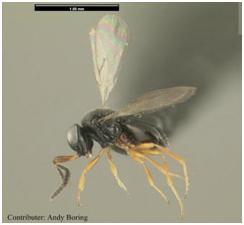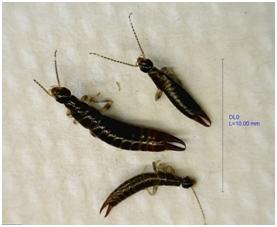 |
|
|
|

|
|||
| |
|||
Bagrada bugs have been very active in desert cole crops since September. The population in Yuma Valley slightly decreased over the past week due to relatively lower temperatures. However, the number of bagrada bugs is expected to increase as the temperature keeps warm for at least another week. So far insecticide applications are still the only and the most promising weapon to knockdown bagrada bugs. Good news is that several egg parasitic wasps have been found to attack bagrada bugs. Dr. Walker Jones, a research entomologist from USDA discovered one native natural enemy, Telenomus podisi, an egg parasitoid wasp known to attack other stink bug species that can successfully develop and emerge from bagrada eggs, along with two species of egg parasitoids in the genus Trissolcus from France. Surveys for bagrada bug parasitoid in its native ranges such as India and South Africa are currently being conducted by entomologists. However, this is only the beginning, the forging behavior and parasitism rate on bagrada bugs in the field remains unclear. Other natural enemies that have been observed to attack bagrada bugs include spiders, assassin bugs, and earwigs. Dead bagrada bodies on spider webs are often seen in the field and greenhouse cages. Late instars or adults of assassin bugs have been observed in the field to prey on bagrada bugs, and other predatory stink bugs may feed on bagrada as well. Omnivorous earwigs were found to feed on bagrada eggs in our greenhouse colony at Yuma Ag Center and possibly feed on early stages of bagrada nymphs. These natural enemies may somehow balance the pest population from outbreak but they may not provide the same protection to your crop as the insecticides do, especially in the desert. Keep in mind that biological control will work better when conservation practices are applied, such as using a selective insecticide, preserving natural habitats or planting nectar-rich flowering plants neighboring to crops. Although a biological control program for bagrada bugs may not be achieved very soon, we can start at a small scale and conserve those natural enemies in your garden or farm.
Click picture to listen Click picture to listen to Ta-I To contact Ta-I Huang go to: huang@cals.arizona.edu
|
|||
| Back | |||
For questions or comments on any of the topics please contact Marco Pena at the Yuma Agricultural Center. |
|||
| Home | Cotton
| Veggies | Forages
| Grains | Citrus
| Crop x Crop Insects | Diseases| Weeds | Pesticides | Economics | News | Weather | Research | Photos | Contacts | General Info. Copyright © 2001 University of Arizona, College of Agriculture and Life Sciences Webmaster: Al Fournier (acis@ag.arizona.edu) |
|||




